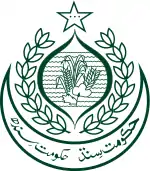Ror dynasty
The Ror dynasty (Sindhi: روهڙا راڄ) was a power from the Indian subcontinent that ruled modern-day Sindh and northwest India from 450 BC.[1] The Rors ruled from Rori and was built by Dhaj, Ror Kumar, a Ror Kshatriya, in the 5th century BCE. Rori has been known by names such as Roruka and Rorik since antiquity. As capital of the Sauvira Kingdom, Roruka is mentioned as an important trading center in early Buddhist literature.[2] Buddhist Jataka stories talk about exchanges of gifts between King Rudrayan of Roruka and King Bimbisara of Magadha.[3] Divyavadana, the Buddhist chronicle has said that Ror historically competed with Pataliputra in terms of political influence.[4] The scholar T.W. Rhys Davids has mentioned Roruka as one of the most important cities of India in the 7th century BCE.[5]
Ror dynasty | |
|---|---|
| 450 BC–489 AD | |
| Capital | Rori |
| Religion | Buddhism Hinduism |
| Government | Absolute Monarchy |
| Maharaja | |
| Historical era | Iron Age India |
• Established | 450 BC |
• Disestablished | 489 AD |
Part of a series on the |
|---|
| History of Sindh |
 |
| History of Pakistan |
Shortly after the reign of Rudrayan, in the times of his son Shikhandi, Roruka got wiped out in a major sand storm.[6] This event is recorded in both Buddhist (Bhallatiya Jataka) and Jain[7] annals. It was then that the legendary Dhaj, Ror Kumar (Rai Diyach in Sindhi folklore) built Rori Shankar, Rohri and Sukkur in Pakistan in the year 450 BC.
List of rulers
Following the foundation of Rori Shankar is Rohri and Sukkur in Pakistan by Dhaj, Ror Kumar, and 42 kings followed him one after the other until Raja Ror. Listing them starting from 450 BC until 489 AD, the dynasty proceeded as follows:[8]
- Dhaj, Ror Kumar
- Kunak
- Rurak
- Harak
- Devanik
- Ahinak
- Paripat
- Bal Shah
- Vijay Bhan
- Khangar
- Brihadrath, Raja Ror
- Har Ansh
- Brihad-datt
- Ishman
- Sridhar
- Mohri
- Prasann Ket
- Amirvan
- Mahasen
- Brihad-dhaul
- Harikeert
- Som
- Mitravan
- Pushyapata
- Sudaav
- Bideerakh
- Nahakman
- Mangalmitra
- Surat
- Pushkar Ket
- Antar Ket
- Sutjaya
- Brihad-dhwaj
- Bahuk
- Kampjayi
- Kagnish
- Kapish
- Sumantra
- Ling-laav
- Manasjit
- Sunder Ket
- Dadror
The bards report that Dadror was poisoned by his head priest, (Dewaji), in 620 AD and he was followed by five Brahmin kings before the capture of Rori or Al Ror by the Arabs.
See also
References
- http://www.historyfiles.co.uk/KingListsFarEast/IndiaSindh.htm
- Derryl N. MacLean (1989), Religion and Society in Arab Sind, BRILL, p.63 ISBN 9004085513
- "The Story of Rudrayana". Archived from the original on 3 June 2013. Retrieved 8 December 2015.
- "The Divyavadana (Tibetan version) reports: 'The Buddha is in Rajgriha. At this time there were two great cities in Jambudvipa: Pataliputra and Roruka. When Roruka rises, Pataliputra declines; when Pataliputra rises, Roruka declines.' Here was Roruka of Sindh competing with the capital of the Magadha empire." Chapter 'Sindhu is divine', The Sindh Story, by K. R. Malkani from Karachi, Publisher: Sindhi Academy (1997), ISBN 81-87096-01-2
- Page 317, Lord Mahavira and His Times, by Kailash Chand Jain, Published 1992 by Motilal Banarsidass Publications, ISBN 81-208-0805-3
- Page 174, Alexander's campaigns in Sind and Baluchistan and the siege of the Brahmin town of Harmatelia, Volume 3 of Orientalia Lovaniensia analecta, by Pierre Herman Leonard Eggermont, Peeters Publishers, 1975, ISBN 90-6186-037-7, 978-90-6186-037-2
- Story of Udayan and the town of Vitabhaya
- Ror Itihaas Ki Jhalak, by Dr. Raj Pal Singh, Pal Publications, Yamunanagar (1987) pp. 89-92